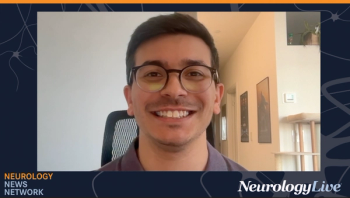
Multidisciplinary Care Paths That Improve Neurosarcoidosis Management
Spencer Hutto, MD, associate program director of the adult neurology residency at Emory University, outlined the key diagnostic nuances, treatment considerations, and emerging therapeutic strategies shaping modern neurosarcoidosis care.
Neurosarcoidosis represents one of the most complex and variable inflammatory disorders encountered in neurology, characterized by granulomatous inflammation of the central and peripheral nervous systems. While sarcoidosis is a multisystem disease most often affecting the lungs, lymph nodes, and skin, neurologic involvement occurs in approximately 5% to 15% of patients and can affect virtually any structure along the neuraxis. Clinical presentations may include meningitis, cranial neuropathies, myelitis, or mass-like brain lesions, often mimicking demyelinating or infectious diseases. Diagnosis remains challenging, frequently requiring integration of systemic imaging, histopathologic evidence, and exclusion of alternative causes.
To provide deeper insight into distinguishing clinical and imaging features, therapeutic approaches, and emerging treatment strategies, NeurologyLive® spoke with
NeurologyLive: Overlap with other disorders, what are the key clinical and imaging clues that distinguish it?
Specer Hutto, MD: In stark contrast to most primary neuroimmune disorders, neurosarcoidosis is almost always one component of a systemic disease whereby sarcoidosis affects other organs. Thorough evaluations for systemic disease with CT or PET CT of the whole body are often necessary to reveal systemic inflammatory foci, which may serve as a biopsy target preferable to a neurologic one.1 Nervous system manifestations frequently lead to the patient’s presentation for medical evaluation, and importantly, the patient may or may not be known to have systemic sarcoidosis at the time of initial evaluation.2 The discovery of systemic sarcoidosis, however, is often one of the major clues that heighten suspicion for neurosarcoidosis causing the patient’s symptoms.
While it is important to acknowledge that sarcoidosis can affect any aspect of the central or peripheral nervous system, there are certain scenarios that should heighten the suspicion for neurosarcoidosis in those without known systemic disease, and they include meningitis (both leptomeningitis and pachymeningitis are possible and may be complicated by hydrocephalus), cranial neuropathies (especially facial and optic, or when multiple in occurrence), and myelitis.3 In comparison to other forms of neuroinflammation, especially CNS demyelinating disorders, sarcoidosis is more likely to present subacutely or chronically (a tempo that it shares with IgG4-related disease), but it may act in an acute fashion if the presentation is associated with seizures (in the case of those with meningeal or brain parenchymal disease) or ischemic strokes (the inflammation can invade brain parenchyma via Virchow-Robin spaces, which can lead to a granulomatous peri-angiitis or frank vasculitis).4
On MRI the brain or spinal cord parenchyma can be affected, and usually this occurs in an “outside-in” morphology whereby the surface and subependymal regions of the parenchyma are most densely affected.5 In the spinal cord, the dorsal subpial region is a frequent target and may lead to the appearance of a trident sign on post-contrasted studies.6 Meningeal inflammation on standard-strength Tesla MRIs is a finding that favors neurosarcoidosis over CNS demyelinating disorders (noting that MOG antibody disease rarely presents with cortical encephalitis in a way that could appear similarly). CSF analysis usually shows a low-grade lymphocytic pleocytosis and may reveal hypoglycorrhachia, which is unusual for other neuroinflammatory disorders, and CSF analysis is additionally critical in excluding carcinomatous or lymphomatous metastases as well as CNS infections (fungal, spirochetal, and tuberculous infections additionally share the time course of neurosarcoidosis), which may appear very similarly, both neurologically and systemically.7
Current Standard of Care, When to Escalate
How best to treat neurosarcoidosis remains a major future research priority as there are currently no FDA-approved treatments. The medications most commonly utilized, like corticosteroids and standard immunosuppressants (methotrexate, azathioprine, mycophenolate mofetil), have a historical precedent for their use, but long-term corticosteroid use is fraught with complications and retrospective data suggests that standard immunosuppressants may struggle to durably suppress disease activity.8 In the last ten years, retrospective studies have identified tumor necrosis factor alpha inhibitors (TNFi, infliximab and adalimumab) as treatments useful in severe and medically refractory disease.9,10 Unless other treatments have failed or there is an overlapping concern for a CNS demyelinating disease, rituximab should be held in reserve given recently published evidence that shows it seldom works outside of a cranial neuropathy phenotype.11
As outlined in recent expert consensus guidelines, treatment strategies should ideally align with disease severity and phenotype, which reflects a shift towards treating proportionately to disease severity at onset via an induction approach with TNFi rather than using an escalator approach to intensifying a patient’s treatment regimen.12 These more severe phenotypes include moderate-severe myelitis, pachymeningitis or leptomeningitis with elevated intracranial pressure, symptomatic brain parenchymal disease, and moderate-severe optic neuritis.12
Multidisciplinary collaboration
Multidisciplinary collaboration with other providers who manage sarcoidosis is an essential component in managing individual patients with sarcoidosis, especially given the vast majority of neurosarcoidosis patients will have disease elsewhere.2 The benefits are at least threefold, including the increased confidence in the diagnosis that comes from identification of typical sarcoidosis manifestations in other organs (especially when biopsies are not obtained directly from neurologic tissue), the need to target treatment in a way that addresses the worst manifestation of the disease (often neurologic when present, but may occasionally be another organ), and monitoring feedback regarding how the patient is responding to treatment (ophthalmology involvement is especially germane to the neurologist’s work given the frequency of optic nerve involvement).
At a minimum, rheumatologists should be included in the core team of physicians managing the patient as they can offer suggestions for testing for differential diagnostic considerations, and they have in-depth experience with the disease modifying treatments used in this disorder that neurologists often do not have.
Similar to how neurology is a field of subspecialties, there are often medical subspecialists with a specific interest in sarcoidosis, and establishing connections with these physicians can be very beneficial to the care we provide as neurologists to patients with neurosarcoidosis. The
Emerging Treatments for Refractory Disease
After years of sporadic reports of the effectiveness of infliximab in isolated cases, a multi-institutional series that retrospectively examined its effectiveness was published in 2017 representing 66 patients at 6 clinical sites across the United States.9 Since that time, other studies have replicated those findings by also demonstrating its utility in the treatment of neurosarcoidosis.13,14 Similarly, adalimumab is a TNFi in the same class as infliximab and primarily differs in how it is administered (subcutaneously versus intravenously for infliximab).
Two studies from single institutions have published their experience with adalimumab in treating neurosarcoidosis in a combined total of 17 patients, and those studies reported a majority of patients responded.10,15 A multi-institutional retrospective study examining the effectiveness of adalimumab in the treatment of CNS sarcoidosis from academic centers across the United States and Canada is forthcoming, which will be an important step forward in evaluating the utility of the medication for this purpose. While awaiting additional data in the present era, adalimumab has traditionally been considered when infliximab has failed (either outrightly or as a result of antidrug antibody formation) or there are insurmountable circumstances preventing intravenous administration of medications.
Prognostic Factors
Factors influencing prognosis is a heavily understudied area in the field, especially considering disease severity can range from minimal/mild forms (facial neuropathy that completely recovers without recurrent events) to severe and disabling (tumefactive brain lesions that often leave residual symptoms, have a high frequency of relapsing, and typically fail non-TNFi-based treatment regimens). In one large study examining factors associated with long-term outcomes, older age, peripheral nervous system involvement, and higher baseline disability scores were associated with an increased risk of mortality.16 Relapses of neurologic disease occurred at three times the rate of non-neurologic relapses, which was reduced in frequency by cyclophosphamide, methotrexate, and infliximab.16 Most patients (89%) were alive at 10 years, which is comparatively lower to CNS demyelinating diseases.16
Roughly one-fourth of patients with optic neuritis experience significant disability, and a recent study identified those patients with severe visual impairment at the time of presentation and occurrence of relapses subsequently were more likely to experience poor visual outcomes in the long-run.17,18 Several recent studies have more clearly outlined the expected clinical course in patients with certain phenotypes (hydrocephalus, tumefactive brain parenchymal lesions, pachymeningitis, cauda equina disease), but none of these studies have specifically examined what factors correlate with a good or poor outcome.19–22
Treatment Adverse Effects
Before initiating treatment, it is important to obtain baseline and periodic blood counts and chemistries as most of the commonly used medications have the potential to impact these tests. Liver enzyme elevations are not infrequent in the setting of treatment (methotrexate, azathioprine, and adalimumab especially), and substituting the medication may be necessary if transiently holding it or lowering the dose does not normalize liver function or begins to compromise the treatment efficacy. Those of childbearing potential should be counseled on the teratogenicity of some of the medications used (methotrexate notably) and the importance of contraception. Folate supplementation is necessary while using methotrexate to limit the potential for systemic adverse effects.
Those on chronic steroids need close monitoring for a variety of potential complications, including hyperglycemia and development of diabetes, hypertension, weight gain, cataracts, peptic ulcer disease, insomnia, mood alterations, oral thrush, moon facies, and osteoporosis, among others. Proton pump inhibitors are necessary for the prevention of GI ulceration, and trimethoprim-sulfamethoxazole is used for the prevention of PJP when prednisone doses are 20 mg daily or more. Unlike other neuroimmune disorders receiving steroids, the decision to supplement vitamin D in sarcoidosis needs to be carefully approached as granulomas have the potential already to convert inactive vitamin D to its active form, which places the patient at risk for hypercalcemia.
Patients should undergo screening for infections (HIV, HBV, HCV, and TB) that may place them at higher risk for complications, particularly for latent TB infection while on TNFi. Infusions reactions may occur with infliximab, and skin rashes are not uncommon with adalimumab. As a class, TNFi may exacerbate demyelinating disorders, emphasizing the need for confidence in the neurosarcoidosis diagnosis given the aforementioned differential diagnoses, and may be associated with heart failure (either exacerbating existing heart failure or its new development).
As a final note, if there are concerns for neurologic worsening that raise the potential for a relapse, the possibility of an opportunistic infection occurring instead should always be entertained in those on immunomodulatory therapies.
Management of Chronic Symptoms
There are no studies that specifically address the management of symptoms in the care of neurosarcoidosis patients, but in general, patients with neurosarcoidosis may suffer from symptoms similarly seen in other neuroimmune disorders, including fatigue, pain, spasticity, incontinence, and difficulty sleeping. Pain may benefit from physical and occupational therapy as well as treatments focused on the direct underlying cause (muscle relaxants and botulinum toxin for spasticity, gabapentinoids and sodium channel anticonvulsants for neuropathic pain, carbamazepine or oxcarbazepine for paroxysmal spasms). Multiple factors may contribute to difficulty sleeping, including medications (steroids especially), development of sleep apnea (in which case a polysomnogram could be useful), pain, and nocturia. Urinary incontinence is commonly encountered in those with myelitis and determining the exact nature of the problem best leads to the solution (detrusor overactivity, detrusor sphincter dyssynergia, loss of bladder perception, impaired contractility). In addition to an evaluation by urology and the use of symptomatic medications, scheduled voiding can be helpful and reducing liquid intake in the hours before bedtime may help with nocturia.
REFERENCES
1.Stern BJ, Royal W, Gelfand JM, et al. Definition and Consensus Diagnostic Criteria for Neurosarcoidosis: From the Neurosarcoidosis Consortium Consensus Group. JAMA Neurol. 2018;75(12):1546-1553. doi:10.1001/jamaneurol.2018.2295
2.Fritz D, van de Beek D, Brouwer MC. Clinical features, treatment and outcome in neurosarcoidosis: Systematic review and meta-analysis. BMC Neurol. 2016;16(1). doi:10.1186/s12883-016-0741-x
3.Hutto SK, Bou GA. The Neuroimaging Spectrum of Neurosarcoidosis. Clinical Neuroimaging. 2025;2(1). doi:10.1002/neo2.70030
4.Hutto SK, Kyle K, Balaban DT, Martinez-Lage M, Venna N. Ischemic stroke in neurosarcoidosis: A retrospective cohort analysis. Mult Scler Relat Disord. 2022;68. doi:10.1016/j.msard.2022.104227
5.Law LY, Riminton DS, Nguyen MA, Barnett MH, Reddel SW, Hardy TA. The spectrum of immune-mediated and inflammatory lesions of the brainstem: Clues to diagnosis. Neurology. 2019;93(9):390-405. doi:10.1212/WNL.0000000000008015
6.Zalewski NL, Krecke KN, Weinshenker BG, et al. Central canal enhancement and the trident sign in spinal cord sarcoidosis. Neurology. 2016;87(7):743-744. doi:10.1212/WNL.0000000000002992
7.Pawate S. Sarcoidosis and the Nervous System. Continuum. 2020;26(3):695-715.
8.Bitoun S, Bouvry D, Borie R, et al. Treatment of Neurosarcoidosis A Comparative Study of Methotrexate and Mycophenolate Mofetil. Neurology. 2016;87:2517-2521.
9.Gelfand JM, Bradshaw MJ, Stern BJ, et al. Infliximab for the Treatment of CNS Sarcoidosis A Multi-Institutional Series. Neurology. 2017;89:2092-2100.
10.Hutto SK, Kyle K, Cavanagh JJ, Reda H, Venna N. Adalimumab for CNS sarcoidosis: single-center experience and literature review. J Neurol. 2021;269(4):2064-2072. doi:10.1007/s00415-021-10793-2
11.Hutto SK, Balaban D, Rohm Z, et al. Rituximab in pathologically confirmed sarcoidosis affecting the central nervous system: a multi-center retrospective study. J Neurol. 2025;272(8). doi:10.1007/s00415-025-13209-7
12.Manzano GS, Eaton J, Levy M, et al. Consensus Recommendations for the Management of Neurosarcoidosis. Neurol Clin Pract. 2025;15(2). doi:10.1212/cpj.0000000000200429
13.Riller Q, Cotteret C, Junot H, et al. Infliximab biosimilar for treating neurosarcoidosis: tolerance and efficacy in a retrospective study including switch from the originator and initiation of treatment. J Neurol. 2019;266(5):1073-1078. doi:10.1007/s00415-019-09234-y
14.Fritz D, Timmermans WMC, van Laar JAM, et al. Infliximab treatment in pathology-confirmed neurosarcoidosis. Neurol Neuroimmunol Neuroinflamm. 2020;7(5). doi:10.1212/NXI.0000000000000847
15.Shen J, Sugita M, Linares-Lopez A, Shah S, Eckstein C, Lackey E. Adalimumab as treatment for neurosarcoidosis: A case series. J Neurol Sci. 2024;460. doi:10.1016/j.jns.2024.123018
16.Joubert B, Chapelon-Abric C, Biard L, et al. Association of prognostic factors and immunosuppressive treatment with long-term outcomes in neurosarcoidosis. JAMA Neurol. 2017;74(11):1336-1344. doi:10.1001/jamaneurol.2017.2492
17.Webb LM, Chen JJ, Aksamit AJ, et al. A multi-center case series of sarcoid optic neuropathy. J Neurol Sci. 2021;420. doi:10.1016/j.jns.2020.117282
18.Nakirikanti AS, El Sammak S, Tyor W, Hutto SK. Predictors of visual outcome in optic neuropathy of sarcoidosis. J Neuroimmunol. 2025;400. doi:10.1016/j.jneuroim.2025.578529
19.Bou GA, Garcia-Santibanez R, Castilho AJ, Hutto SK. Neurosarcoidosis of the Cauda Equina: Clinical Course, Radiographic and Electrodiagnostic Findings, Response to Treatment, and Outcomes. Neurol Neuroimmunol Neuroinflamm. 2022;9(4). doi:10.1212/NXI.0000000000001170
20.Chakales PA, Herman MC, Chien LC, Hutto SK. Pachymeningitis in Biopsy-Proven Sarcoidosis: Clinical Course, Radiographic Findings, Response to Treatment, and Long-term Outcomes. Neurol Neuroimmunol Neuroinflamm. 2022;9(6). doi:10.1212/NXI.0000000000200028
21.El Sammak S, Lec BM, Bou GA, Wagstaff W V., Lawson EC, Hutto SK. Hydrocephalus in Neurosarcoidosis: Clinical Course, Radiographic Accompaniments, and Experience with Shunting. Mult Scler Relat Disord. 2023;79. doi:10.1016/j.msard.2023.105040
22.Bou GA, El Sammak S, Chien LC, Cavanagh JJ, Hutto SK. Tumefactive brain parenchymal neurosarcoidosis. J Neurol. 2023;270(9):4368-4376. doi:10.1007/s00415-023-11782-3
Newsletter
Keep your finger on the pulse of neurology—subscribe to NeurologyLive for expert interviews, new data, and breakthrough treatment updates.



































